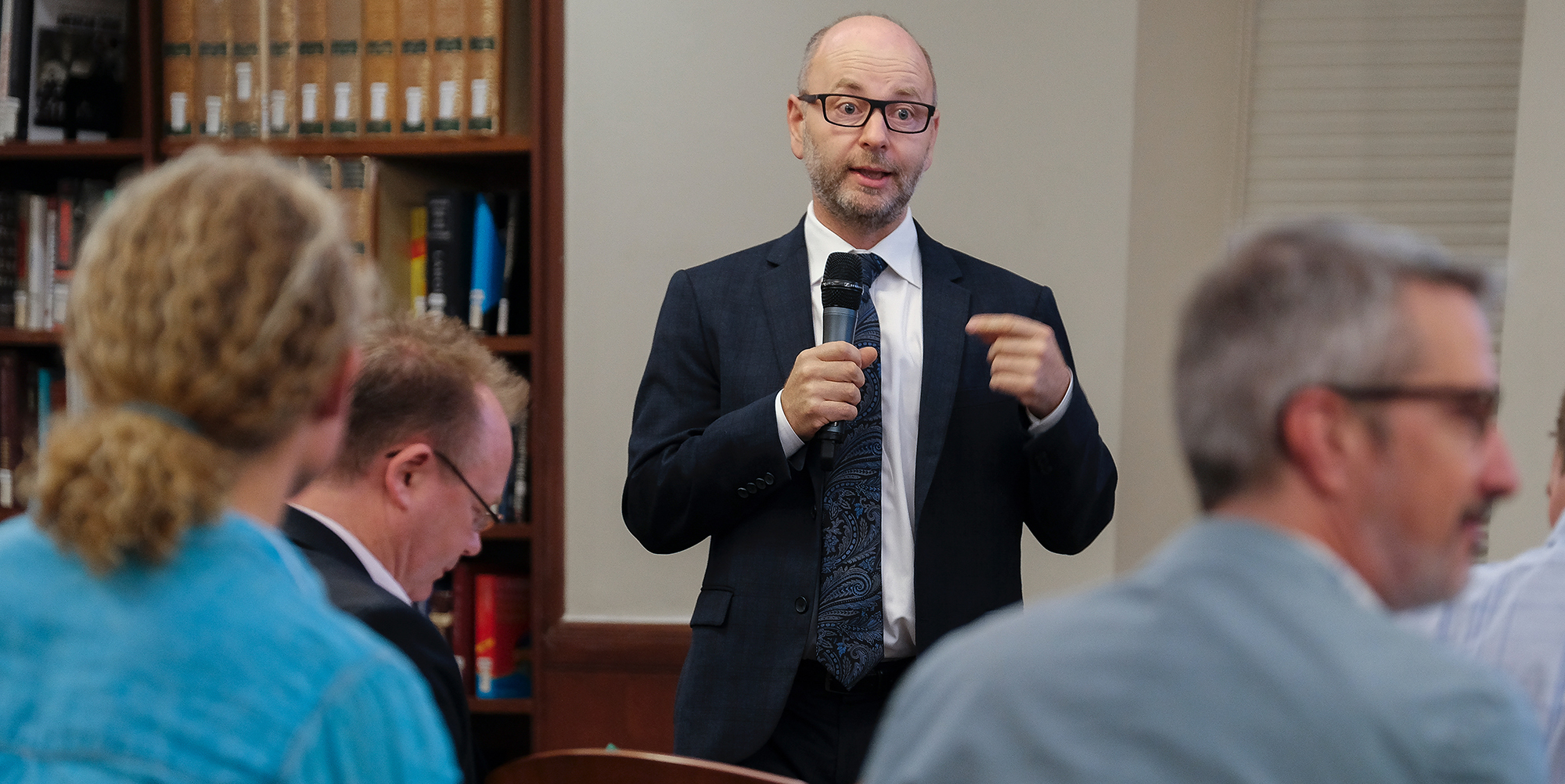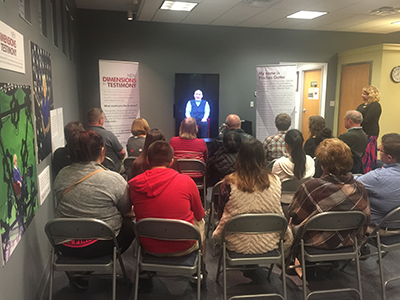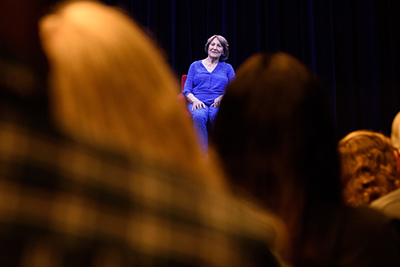Scholars Consider Ethics, Possibilities, and Critiques of New Dimensions in Testimony at Digital Approaches to Genocide Studies Conference

 New Dimensions in Testimony interview of Pinchas Gutter on display at CANDLES Holocaust Museum and Education Center in Terre Haute, Indiana
New Dimensions in Testimony interview of Pinchas Gutter on display at CANDLES Holocaust Museum and Education Center in Terre Haute, Indiana“What are the physical and psychological consequences of enduring five days of interviewing?”
“Is it synthetic to ask questions in a random way, or natural?”
“If we collect answers to thousands of questions knowing that there are less than 200 questions typically asked of survivors, are we serving history by asking those questions at the expense of the survivor him or herself? If we collect 200 of the most commonly answered questions to reduce the workload on the survivor but don't’ ask the questions that are most meaningful to them, do we do a mis-service to their memory in pursuit of history?”
“If we do ask over a thousand question over five days and the system is not able to interpret their questions accurately or find appropriate answers to those questions, what do we do? That is– what do we do about the fact that this person has spent their time to give us a very large portion of their lives?”
“Shall we create digital versions of the interviewee? If we do, when would we use it? If we don’t, what if we need it? Does 360 volumetric capture matter? Why not use a single camera and not worry about volumetric capture at all? What is the lowest fidelity medium we could use? Would they be as effective in communicating the testimony itself?”
“What if survivors don’t like the medium, do we still pursue the project?”
These are just a few of the hundreds of questions the creators of USC Shoah Foundation’s New Dimensions in Testimony (NDT) project – which renders Holocaust survivor accounts as interactive digital witnesses – had to ask before they even considered beginning the project, and a list of questions Stephen Smith, executive director of USC Shoah Foundation, ran through when describing the project last month on a panel at the Institute’s 2017 International Conference “Digital Approaches to Genocide Studies.”
The project – now 16 testimonies strong and still fielding more – was on display at the Conference, attended by dozens of researchers from across the world. This particular panel focused on NDT and its impact on the future of testimony at a time when fewer and fewer storytellers remain.
Chaired by Jason Lustig, of the History Department at the University of California, Los Angeles, the panel allowed researchers to take on critical questions about the validity of digital testimony with the creators of NDT, and enabled an audience of peers to question and interact with a sample of the technology NDT uses.
Kia Hays, program manager of NDT at USC Shoah Foundation, described her involvement with the Institute since 2014 and gave a brief introduction to the project by showing attendees survivor Pinchas Gutter’s testimony using an NDT platform.
“Pinchas is one of 16 survivors we’ve now filmed this way,” Hays said, demonstrating the photorealistic Gutter’s reactions to aural stimuli. “We film them for around a week, we ask somewhere around a thousand questions. Then we have a software system where a user can come up and ask their own question. They’ll get a response [the survivor] gave during that interview.”
Alongside Hays, the panel also featured collaborators Dan Leopard, from Saint Mary’s College of California, and Noah Shenker, of Monash University, whose research proposal for entry into the conference analyzed NDT as a site for challenging traditional conceptions and applications of testimony. Both spoke at the conference.
“I’m very interested in how we treat [Pinchas] as a human,” Leopard said. Through his work with the Institute for Creative Technologies at the University of Southern California, he became absorbed in cognitive science and psychoanalysis as a way of critiquing cognitive science.
During his speech, he handed out a comic book about how to read a “virtual human,” and about the intricacies of the “uncanny valley,” where humanoid objects may appear almost, but not quite, like real human beings, eliciting strange feelings of familiarity.
“Pinchas is a much more visual representation of a human, but there are stoppages,” Leopard said. “The consciousness is still in the realm of the uncanny. Any individual chunk of data is actually specifically human, but the interstitial moments between those moments...it’s constantly a disruptive process.”
Where Leopard discussed Pinchas’ representation and its human-ness, Shenker focused on the NDT’s user-edited and -curated approach to gathering testimony.
 New Dimensions in Testimony interview of Fritzie Fritshall at Illinois Holocaust Museum & Education Center (courtesy IHMEC)
New Dimensions in Testimony interview of Fritzie Fritshall at Illinois Holocaust Museum & Education Center (courtesy IHMEC)Pinchas’ memory in those testimonies positioned him as a reliable, seemingly objective witness who was – above all else – recording to survive, and surviving to record. Shenker doesn’t see him this way in his NDT form.
“There was something incredibly ritualistic and quite moving about the encounters between the users of the testimony and Pinchas,” Shenker said. “The nodding of the head as he listened, the eye contact that was maintained between most of the users and Pinchas…”
But Shenker questioned the ethics of this kind of memory disclosure, and its ability to be as accurate as in a regular testimony, where the witness sits in front of one camera, one-on-one with an interviewer asking for his life’s story. He noted, in his presentation, that the questions being asked of digital Pinchas tended to relate to his traumas and difficult experiences, and had become more emotional – they were no longer, according to Shenker, historic and creating knowledge.
The experience, Shenker said, now focused on the user – the agency of the survivor was moved to user-driven imperatives. He explained that Pinchas no longer speaks to listeners from start to finish, but we must ask questions to trigger sporadic narratives.
Normally, we must listen in order to hear the password, the subtext of the narrative, Shenker said. But it’s not about active listening here.
In responding to this and several questions from conference attendees, Stephen Smith spoke about his team’s motivations and hopes for NDT. After running through some statistics about survivors’ comfort speaking about certain subjects over time, and describing how testimony is filmed, Smith likened NDT to an exercise where the survivor is giving testimony in a classroom and is exposed to random questions from the audience.
“When students were sitting in a room with a Holocaust survivor and they heard that 45 minute episodic short version of their testimony, they very rarely raised their hand and said, ‘could you qualify – was that the seventh or eighth of May that you were deported from the Warsaw ghetto?,’” Smith said. “Their question was more about why, what does it mean, how do you feel...what does this mean to me as I try to unravel this past and what you’ve just thrown at me, how do I make sense of that.”
Very often, he said, the reference is already not the survivor but the individual and their struggle to understand the past. The survivor, however, maintains agency because they want the students to start addressing the struggle in the context of their own lives.
“That’s why they’re sitting in the classroom in the first place,” Smith said. ““So what is testimony…? It is on the one hand much more performative. There is a green screen behind him, and lights and a stereo pair of cameras capturing his 3D image in that space – hardly natural. However, when in that space, notwithstanding the apparatus around him...once that camera starts rolling what comes out is testimony. Because the space itself and the memory of the space and what happened...it doesn’t matter how he tells it...he goes into a storytelling mode, which is testimonial in its core. The emotionality that goes with that is that he cannot separate himself from that space, no matter what the situation is.”
Like this article? Get our e-newsletter.
Be the first to learn about new articles and personal stories like the one you've just read.